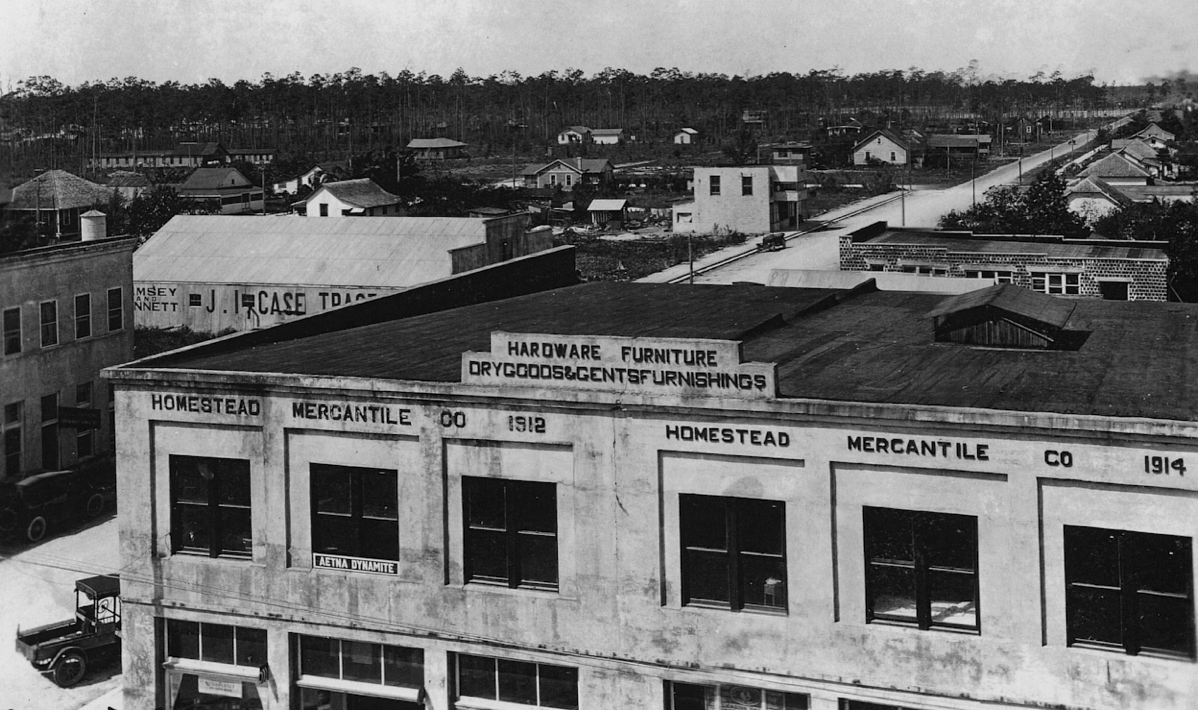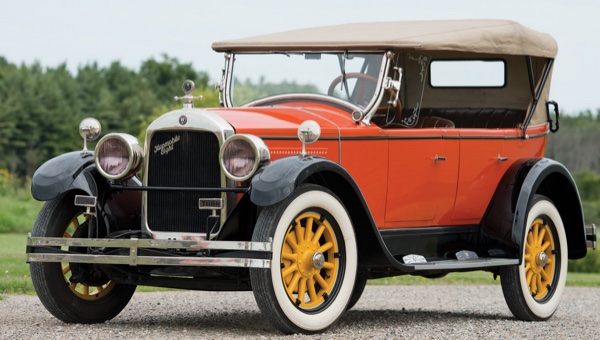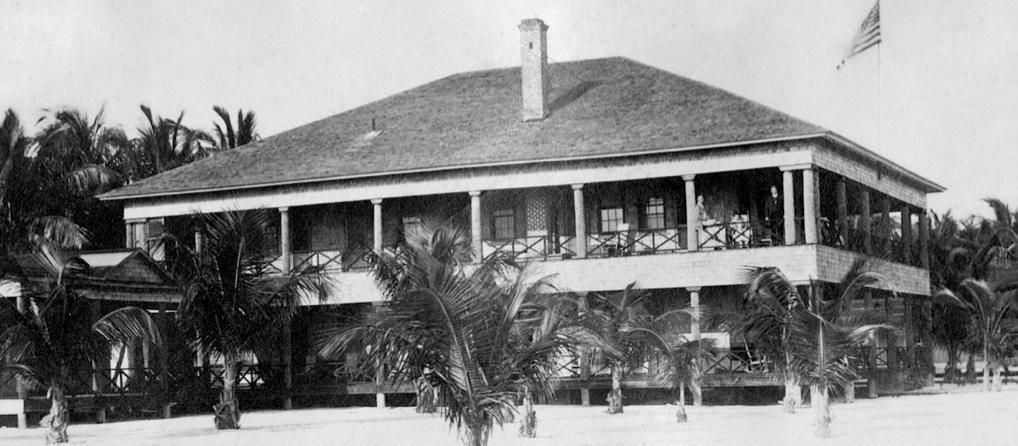Hupmobiles in Homestead
by Jeff Blakley
A friend recently posed a question to me about Glen Simmons that I could not answer so I set out to do so. Laura Ogden is the authority on Glen Simmons but I did not have ready access to her books, Gladesmen and Swamplife, both available through online booksellers. I started looking in the local newspapers for information about Glen and discovered that his father, James, was killed in an automobile accident in 1928 involving a Hupmobile driven by A. B. Cain. Algeron Benjamin Cain, Jr. was driving west at sundown on the East Glade Road (now known as East Mowry) in his Hupmobile and Glen’s father was a passenger in a truck driven by his 15-year-old son, Alvin, who was headed south on N. E. 2nd Road. Glen’s father was ejected from the truck in the accident and died of a broken neck.
I had known that Homestead had a Hupmobile dealership in the 1920s but knew nothing more about it. This post is about Hupmobiles, the owner of the dealership, M. E. Fletcher, and his relationship with the subject of my previous post, Stephen M. Alsobrook.
Mark Edward Fletcher was born on April 10, 1891 in Helena, Telfair County, Georgia, the son of James C. Fletcher and Martha B. Humphreys. In June of 1917, he was a flagman on the Georgia, Florida and Alabama Railway in Richland, Georgia. He and Annie Irene Alsobrook, the daughter of Stephen M. Alsobrook, were married in Silver Palm by the Rev. O. C. Seevers of the Methodist Episcopal Church, South on March 3, 1915.1 They moved back to Richland, where his first two children, Martha Corine and Milton Olynthus, were born. He then moved to Bainbridge, in Decatur County, Georgia, where his last two children, James Alsobrook and Thomas Stephen, were born. Thomas was born on February 21, 1922 so Mark did not come back to South Florida before then.
By 1922, Mark’s father-in-law, Stephen M. Alsobrook, had become quite wealthy through real estate speculation and had built the Alsobrook Filling Station, located on the southwest corner of Krome and N. 2nd Street in Homestead.2 Mark and his family apparently decided to move to Homestead to become rich like so many other people were doing. Shortly after he arrived in Homestead, his father-in-law set Mark up in business as a Hupmobile dealer.
On March 13, 1925, The Homestead Enterprise reported that “M. E. Fletcher has re-opened the garage building opposite the Enterprise office and is establishing his Hupmobile agency there. Mr. Fletcher announces that he will improve the building both inside and out.”

Fletcher’s Hupmobile agency was in the building at the left center in this photograph, the one that has the sign for J. I. Case Tractors on the side. This photograph was taken from the top of the Horne Building, a three-story building erected in 1923. The Bank of Homestead was enlarged in 1925, so this photograph was taken sometime between late 1925 and late 1926, when the ’26 hurricane caused significant damage to the Homestead business district. The Enterprise building is the tile-block building visible behind the Homestead Mercantile Co. building.
Mark only had a 9th grade education but with his father-in-law’s support, he became a member of the Redland Realty Board, with offices in the Alsobrook Arcade3 and established himself as a realtor.
Fletcher operated his dealership out of the garage building until October of 1925, when he sold the building to Dexter Smith.4 He moved his business to 414 N. Krome Avenue and advertised that location in the newspaper in April of 1926.5
On September 18, 1926, a severe hurricane struck Miami and also caused a lot of damage in Homestead. In October, Hupmobiles were being advertised by the Gordon Thompson Motor Co. at 103 N. Krome Avenue and by the Fletcher Motor Co., possibly because Fletcher’s business had been damaged by the storm.
The Fletcher Motor Co. was advertising the new Hupmobile Eight for $1945 to $2595 f.o.b. Detroit. Hupmobile had manufactured a 4 cylinder model from 1909 until 1925 and the eight cylinder model was new for the 1926 model year.

On November 2, 1926, Fletcher advertised the Hupmobile Six for $1385. The price for the sedan, coupe, and roadster were all the same and the touring car was slightly less expensive at $1325.

The Citizens Bank of Homestead, which was next door to the Alsobrook Arcade, opened on October 6, 19206 and failed on July 2, 1926.7 But the Bank of Homestead was still in business, though it would also close on June 17, 1927.8 Fletcher did not advertise much in 1927, possibly because he had as much business as he could handle. On November 8, 1927, the Homestead Leader noted that he would be showing the new 1928 Hupmobile models in his showroom at 414 N. Krome Avenue.
Both banks in Homestead were struggling to reorganize and re-open but neither succeeded. They were both granted multiple extensions by the State Banking Board but neither was able to raise sufficient funds to re-open. By the middle of 1928, the hopes of businessmen and citizens had been dashed and without a bank, economic activity in Homestead started to decline. No mention of the Fletcher Motor Company was made by the local newspapers in 1928 but several mentions of Stephen Alsobrook and Mark Fletcher in 1929 indicate that they had moved back to Tifton, Georgia.
An interesting note appeared in the August 29, 1929 issue of the Homestead Leader which stated that William Nobles had been arrested on a charge of making moonshine at his house “three doors west of Sixth avenue on King’s Highway.” Nobles was the owner of the meat market in Homestead before Charles T. Fuchs purchased it in 1913 and he also platted Nobles Addition to Homestead in 1913. Times were tough.
On September 28, 1929, a Category 3 hurricane struck Tavernier in the Florida Keys, causing significant damage to business buildings in Homestead. “The garage and show room building of the Fletcher Motor Co., on North Krome avenue, between N. W. Fourth and Fifth streets, crumbled under the force of the winds …”9 and that put the finishing touches on the saga of the Hupmobile in Homestead. C. C. Cooper, formerly with Fletcher Motor, advertised that he was “at [his] old stand – Garage in rear of 15 N.W. 2nd Second St.”10 and then, on November 21, 1929, it was reported that “M. E. Fletcher arrived Saturday from Fitzgerald, Ga., to wind up his business affairs in order that he may make his future home in Fitzgerald.”
In 1931, the Homestead Rotary Club donated $25 towards the cost of clearing the wreckage of the Fletcher Motor Co. building and a tennis court was built on the site, which was was owned by Stephen M. Alsobrook.11 The tennis court was later demolished when Robert E. “Lefty” Sherard built his dry cleaning business there.
The history of Homestead is one of dynamism – people constantly coming and going, most of them leaving no trace of their stay here. The history that has been told in the past about this area is very biased towards the upper and middle-classes but we must remember that history is told by the victors, not by the defeated. One of my motivations in writing about the history of this area is to tell the story of the “defeated.”
_____________________________________________________________________
- Homestead Enterprise, March 11, 1915, p. 5
- The Homestead Enterprise, on March 2, 1922, p. 1, reported that Alsobrook had paid J. W. Conner $4,000 for the southwest corner of Hogard St. (now 2nd Street) and Krome. Conner had paid $3,000 for the lot a few months prior to selling it to Alsobrook.
- The Miami News, August 16, 1925
- Miami Herald, October 18, 1925, p. 50
- Homestead Enterprise, April 23, 1926
- Homestead Enterprise, October 7, 1920
- Miami Herald, April 12, 1930
- Tampa Tribune June 19, 1927
- Homestead Leader, October 3, 1929
- Homestead Leader, October 10, 1929
- The Miami News, June 25, 1931

Jeff : my family’s first car was 1928 2-door Coupe with a rumble seat. Jerry ?
Great research!
Interesting, another story that needed telling and saving. Thanks Jeff.
Jeff, hope all’s well.
Maude Lepannen frequently mentioned Hupmobiles in conversations about her early years in and around Homestead, and she or some family member must have owned one of them. Too bad she could not have contributed some memories for your article.
Thanks for the great research as always, Dave.
I have never heard of a Hupmobile and I learned something new today. Thanks!
Great article Jeff, as always. Nice to see comments by Bob and Jerry and others. When I read your articles, I think about the small town I live in and the struggle to keep businesses going with a small population while trying to entice outside people to visit and spend money… Businesses and people come and go, experimenting with dreams.
Thanks again for another interesting story of our beloved Homestead!! I love your passion!
I recall my father, John Fredrick, Sr.,telling me my grandfather, David, once owned a Hupmobile. He came to Homestead in 1924 from Sheboygan, Wisconsin with his wife Pauline and family of 6 children after immigrating from Russia in 1908. They were Germanic in heritage as part of a lineage of Prussians brought to help settle Russia by Catherine the Great in the 1700s. He was a cobbler who owned a shoe repair and sales shop on Krome. His enterprise and hard work epitomized the American spirit and dream.
Nice work, as always, Jeff.
Great looking car – would have given Henry Ford a run for his money…
I enjoyed this article and look forward to many more! Thank you for this beautiful piece of knowledge from the past.